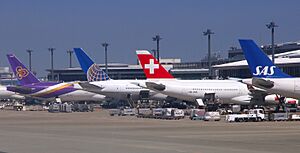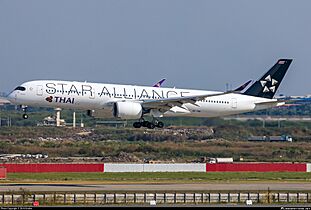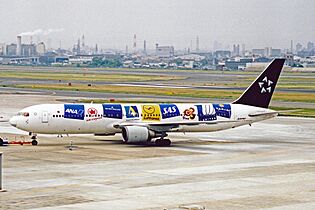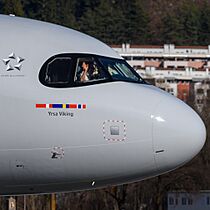Star Alliance facts for kids
 |
|
| Launch date | 14 May 1997 |
|---|---|
| Full members | 26 |
| Non-voting members | 40 affiliates |
| Destination airports | 1,294 |
| Destination countries | 195 |
| Annual passengers (M) | 762 |
| Annual RPK (G) | 1,739 |
| Fleet size | 5,033 |
| Headquarters | Singapore |
| Management | |
| Alliance slogan | Together. Better. Connected. |
Star Alliance is the world's first global airline alliance. Founded on 14 May 1997, it is headquartered on the grounds of Frankfurt Airport in Frankfurt, Germany, with a subsidiary management company in Singapore. Star Alliance is also the world's largest airline alliance by market share as of April 2024, with 17.4% of the market share, compared to 13.7% of SkyTeam and 11.9% of Oneworld.
Star Alliance's 26 member airlines operate a fleet of over 5,000 aircraft, serving more than 1,290 airports in 195 countries on more than 19,000 daily departures. The alliance has a two-tier rewards program, Silver and Gold, with incentives including priority boarding and upgrades. Like other airline alliances, Star Alliance airlines share airport terminals (known as co-locations), and many member planes are painted in the alliance's livery.
History
1997–1999: Founding and early years
On May 14, 1997, an agreement forming the Star Alliance was announced with five airlines across three continents: United Airlines, Scandinavian Airlines, Thai Airways International, Air Canada, and Lufthansa. The alliance chose Young & Rubicam for advertising, with a budget of $25 million (€18 million). The airlines shared the star logo from the beginning, with its five points representing the founding airlines. The alliance adopted its first slogan, "The Airline Network for Earth", with its goal being "an alliance that will take passengers to every major city on Earth".
The now defunct Brazilian airline VARIG joined Star Alliance on 22 October 1997, extending the alliance into South America. Also joining were Ansett Australia and Air New Zealand, expanding Star Alliance to Australia and the Pacific. With the addition of the latter two carriers, the alliance served 720 destinations in 110 countries with a combined fleet of 1,650 aircraft. The next airline to join the alliance is Japan's All Nippon Airways on 15 October 1999, making it the second Asian airline in the alliance.
2000s: Expansion and first decade
During the early 2000s, a number of airlines joined Star Alliance; the Austrian Airlines Group (Austrian Airlines, Tyrolean Airways and Lauda Air) joined on 26 March 2000 and Singapore Airlines on 1 April. BMI (British Midland) and Mexicana joined on 1 July, bringing the alliance's membership to 13. With Singapore Airlines' entry into the alliance, Thai Airways considered moving to OneWorld, but eventually decided to remain. The addition of BMI made London Heathrow the only European hub with two alliances. During the year, Emirates considered joining Star Alliance, but decided against it. That year the now-defunct BWIA West Indies Airways, which had entered an alliance with United Airlines, considered becoming a member but did not. In 2000, the alliance also opened its first three business centers (in Los Angeles, Frankfurt, and Bangkok) and announced the formation of an Alliance Management Team (AMT), the partnership's executive body. In September 2001, Ansett Australia (the alliance's only Australian member) left Star Alliance due to bankruptcy, giving most of the Australian market to Qantas (a Oneworld member). That year, Star Alliance announced the appointment of a new CEO, Jaan Albrecht.
Partner airlines promoted the Star Alliance brand with a ‘Round the World’ ticket (RWT) that offered choices of 19,000, 21,000, and 23,000 miles with stopovers of 15 cities valid for one year. RWT was path-breaking in that travel buffs could visit destinations of their choice by charting a yearlong itinerary without disrupting work commitments. Until then, tourists took annual vacations of two or three weeks, often settling for lesser-known destinations because flights were overbooked during the peak holiday season. Customer loyalty ratings went up, driven by the underlying message – Forget about the countries and cities. Go where the RWT ticket takes you!
Asiana Airlines joined the alliance on March 1st, 2003, Spanair on May 1st, 2003, followed by LOT Polish Airlines (Poland's flag carrier) joining in October. Around this time, Mexicana Airlines left the alliance after deciding not to renew a codeshare agreement with United Airlines, later joining Oneworld. US Airways joined the alliance in May 2004, becoming its second US-based airline. In November Adria Airways, Blue1 and Croatia Airlines joined the alliance as its first three regional members.
Although Star Alliance invited Lineas Aereas Azteca in 2005 to join in mid-2007, the airline filed for bankruptcy. TAP Air Portugal joined on 14 March 2005, adding African destinations to the network. In April 2006, Swiss International Air Lines, the alliance's sixth European airline, and South African Airways (its first African carrier) became the 17th and 18th members.
By May 2007, Star Alliance's 10th anniversary, its members had a combined 16,000 daily departures to 855 destinations in 155 countries and served 406 million passengers annually. The alliance introduced Biosphere Connections, a partnership with UNESCO, the International Union for Conservation of Nature (IUCN), and the Ramsar Convention on Wetlands to promote environmental sustainability.
Today, nearly 30% of global air travellers use the services of our member carriers or, looking at it from an overall industry perspective, two-thirds of worldwide air travellers use one of the three airline alliances.
—Jaan Albrecht, former Star Alliance CEO
VARIG left the alliance on 31 January 2007, and the two Chinese airlines, Air China and Shanghai Airlines, joined on 12 December.
On 1 April 2008, Turkish Airlines joined the alliance after a 15-month integration process beginning in December 2006, becoming its 20th member. EgyptAir, Egypt's national airline and Star Alliance's second African carrier, joined on 11 July 2008.
On 27 October 2009, Continental Airlines became the 25th member of Star Alliance after leaving SkyTeam three days earlier. According to alliance CEO Jaan Albrecht, "Bringing Continental Airlines into Star Alliance has been a truly unique experience. This is the first time an airline has moved directly from one alliance to another, and I would like to thank all those involved in ensuring a smooth switch". At the time, it was rumoured that the switch was Continental's first move in a planned merger with United Airlines. Two months later, Brussels Airlines joined the alliance.
2010s: Further expansion and second decade of operations

Brazilian carrier TAM Airlines joined Star Alliance on 13 May 2010, increasing its foothold in South America. Aegean Airlines, Greece's largest airline by number of passengers, joined on 30 June.
Shanghai Airlines left the alliance on 31 October 2010 when it merged with China Eastern Airlines, a SkyTeam member. On 29 September, the chief executive board approved Ethiopian Airlines as Star Alliance's 30th member, though Ethiopian did not officially join the alliance until December of the following year. In 2010 the alliance flew to 1,172 airports in 181 countries, with about 21,200 daily departures.
Since 2011, the alliance has gained several large members, but it has lost others due to collapse or mergers. On 13 December 2011, Ethiopian Airlines joined, adding five countries and 24 destinations to the alliance's map.
2012 and 2013 were tumultuous years for Star Alliance, starting with two key departures but ending with a major move into Latin America. In Europe, Spanair ceased operations, and BMI left after being acquired by International Airlines Group (IAG), the parent company of Oneworld members Iberia and British Airways. BMI was integrated into British Airways. In North America, Continental merged with United Airlines, reducing Star Alliance's membership further, even if it effectively remained in the alliance after the merger. On 21 June, though, Avianca, TACA Airlines and Copa Airlines joined, massively increasing the alliance's Latin American presence. In November, Blue1 left after becoming an affiliate of parent Scandinavian Airlines. and Shenzhen Airlines joined, augmenting Air China's Chinese network. Taiwanese carrier EVA Air then joined on 18 June 2013, and after TACA's integration into Avianca, the alliance grew to 28 members, making it the largest of the three major airline alliances. On 13 December, Air India was again invited to begin an integration process with Star Alliance and joined the alliance on 11 July 2014.
Following this string of expansions, 2014 opened with two major departures through mergers. First, Brazilian carrier TAM Airlines merged with LAN Airlines to become LATAM Airlines Group, leaving the alliance without a presence in the world's fifth-largest country. Next, US Airways completed its merger with American Airlines and also left the alliance. Both parent companies stayed with Oneworld. On 24 June, though, the alliance finally approved Air India, which joined on 11 July, leaving the alliance at 27 members.
Future expansion centres around the addition of Connecting Partners, subsidiaries or partners of alliance members which will add connectivity to the alliance without becoming full members. Avianca Brasil joined in this way on 22 July 2015, bringing the alliance back into the Brazilian market and partially filling the void left by TAM. South African Airways' low-cost subsidiary, Mango, was initially announced to join as a Connecting Partner in Q3 2016 but has since been delayed. Juneyao Airlines, which codeshares with Shenzhen Airlines, joined as a Connecting Partner on 23 May 2017. On 20 August 2019, Star Alliance announced affiliate member Avianca Brasil's exit from the alliance from 1 September 2019. The departure, however, won't affect Avianca's membership. On 30 September 2019, Adria Airways ceased operations, and the airline exited the alliance on 2 October 2019.
2020s: 25th anniversary and restructuring of several member airlines
The now-defunct regional subsidiary of Thai Airways, Thai Smile joined as a Connecting Partner in February 2020. On January 2024, the Thai Smile brand was discontinued and folded into the parent airline as a result of the reorganization of Thai Airways International following bankruptcy.
On 16 November 2020, Asiana Airlines announced their plans to exit the alliance. Asiana will merge with Korean Air, the South Korean Government confirmed, in a $1.6 billion acquisition by the SkyTeam member. In 2022, Lufthansa announced plans to buy a 40% stake in ITA Airways, a SkyTeam member. If this goes through, then they can become a member of Star Alliance.
On 3 October 2023, Scandinavian Airlines (SAS) announced its plan to leave Star Alliance and join SkyTeam after a consortium including Air France–KLM won the bid in SAS's Chapter 11 reorganization. On April 2024, SAS announced that they will remain in Star Alliance until 31 August 2024. The transition towards an eventual membership in SkyTeam will begin the following day, starting with "loyalty benefits when travelling on most SkyTeam airlines".
Member airlines and affiliates
Members and affiliates
| Member | Joined | Member Affiliates |
|---|---|---|
| 30 June 2010 | ||
| 14 May 1997 | ||
| 12 December 2007 | ||
| 11 July 2014 | ||
| 3 May 1999 | N/A | |
| 15 October 1999 | ||
| 28 March 2003 | N/A | |
| 26 March 2000 | ||
| 21 June 2012 | ||
| 9 December 2009 | N/A | |
| 21 June 2012 | ||
| 18 November 2004 | N/A | |
| 11 July 2008 | ||
| 13 December 2011 | ||
| 18 June 2013 | ||
| 26 October 2003 | N/A | |
| 14 May 1997 | ||
| 14 May 1997 | ||
| 29 November 2012 | N/A | |
| 1 April 2000 |
||
| 10 April 2006 | N/A | |
| 1 April 2006 | ||
| 14 March 2005 | ||
| 14 May 1997 | N/A | |
| 1 April 2008 | ||
| 14 May 1997 |
Connecting Partners
| Connecting Partner | Joined | Affiliates |
|---|---|---|
| 23 May 2017 | N/A |
Intermodal partners
Since August 2022, the German railway provider Deutsche Bahn has been the first intermodal partner of the Star Alliance, whose airlines have been able to assign their own flight numbers for trains.
Former members
| Former member | Joined | Exited | Affiliates | Notes |
|---|---|---|---|---|
| 18 November 2004 | 30 September 2019 |
Darwin Airline |
Ceased operations on 30 September 2019. | |
| 3 May 1999 | 12 September 2001 | Aeropelican Air Services Hazelton Airlines Kendell Airlines Skywest Airlines |
Left the alliance on 12 September 2001 after suffering financial collapse. Ansett resumed operations on 1 October 2001, but would permanently cease operations on 4 March 2002. In 2002, Hazelton and Kendell merged to become Regional Express Airlines. | |
| 22 July 2015 | 31 August 2019 | N/A | Ceased operations on 31 August 2019. | |
| 3 November 2004 | 1 November 2012 | N/A | Left the alliance on 1 November 2012 after SAS took over mainline operations, was a member affiliate of Scandinavian Airlines, and is now a part of CityJet. | |
| 1 July 2000 | 20 April 2012 | BMI Regional Bmibaby |
Merged into British Airways, an International Airlines Group division and a Oneworld member, on 20 April 2012. | |
| 27 October 2009 | 3 March 2012 | Continental Connection Continental Express Continental Micronesia |
Merged with United Airlines on 3 March 2012. | |
| 1 July 2000 | 31 March 2004 | Aerocaribe | Left the alliance in 2004 after deciding not to renew a codeshare alliance with United Airlines, opting instead to codeshare with American Airlines. Ceased operations on 28 August 2010. | |
| 12 December 2007 | 31 October 2010 | China United Airlines | Acquired by China Eastern Airlines, a SkyTeam member, on 31 October 2010. | |
| 1 May 2003 | 27 January 2012 | AeBal | Ceased operations on 27 January 2012. | |
| 21 June 2012 | 27 May 2013 | TACA Regional | Merged with Avianca on 27 May 2013; renamed Avianca El Salvador. | |
| 13 May 2010 | 30 March 2014 | TAM Paraguay | Merged with LAN Airlines, a Oneworld member, on 30 March 2014. | |
| 4 May 2004 | 30 March 2014 | US Airways Express US Airways Shuttle MetroJet (American airline) |
Merged with American Airlines, a Oneworld member, on 30 March 2014. | |
| 22 October 1997 | 31 January 2007 | Nordeste Rio Sul PLUNA |
Ceased operations on 20 July 2006. |
Former affiliates of current members
| Member | Former affiliate | Joined | Exited | Notes |
|---|---|---|---|---|
|
|
|
Folded into Air Canada Express | ||
|
|
|
Folded into Air Canada Express | ||
|
|
|
Folded into Air Canada. | ||
|
|
|
Folded into Air Canada Express | ||
|
|
|
|||
|
|
|
Folded into Air Canada. | ||
|
|
|
Formerly Air India Regional. From 15 April 2022, no longer a part of Air India after its divestment and will be run as an independent Business unit under the Government of India. Thus no longer a member of Star Alliance. | ||
|
|
|
Folded into Air New Zealand. | ||
|
|
|
|||
|
|
|
Merged with ANA Wings | ||
|
|
|
|||
|
|
|
Ceased operations when Avianca filed for Chapter 11 bankruptcy amid the COVID-19 pandemic. | ||
|
|
|
Replaced by Austrian Airlines operations, now known as Austrian myHoliday. | ||
|
|
|
Folded into Austrian Airlines | ||
| Korongo Airlines |
|
|
Folded into Brussels Airlines | |
|
|
|
Merged with EgyptAir | ||
|
|
|
Folded into LOT Polish Airlines | ||
|
|
|
Folded into Lufthansa | ||
|
|
|
Folded into Cityjet | ||
|
|
|
Folded into Singapore Airlines. Some routes transferred to Scoot. | ||
|
|
|
Merged into Scoot. | ||
|
|
|
Folded into South African Airways. | ||
|
|
|
Folded into Swiss International Air Lines after being dissolved. | ||
|
|
|
Absorbed into Swiss International Air Lines. | ||
|
|
|
Folded into Thai Airways | ||
|
|
|
Folded into Turkish Airlines | ||
|
|
|
Became part of United Airlines. | ||
|
|
|
Folded into United Airlines. |
Customer services
Frequent flyer programs, Star Alliance Silver and Gold status
Status miles can be earned across all Star Alliance member airlines’ frequent flyer programmes with only one frequent flyer card and attain Star Alliance Silver status or progress to Gold status, as membership in any Star Alliance airline program gives full access to the whole Star Alliance network with no need to register with any additional programme.
The more a customer flies on the Star Alliance network, the faster miles or points can be earned, which can be used redeem for a reward ticket or upgrade, along with several other rewards in specific airlines. Customers will have to provide their frequent flyer number when booking flights or when checking in whenever they fly with any Star Alliance member airline in eligible booking classes, for miles or points to be credited to their account.
The higher tier status levels of each member airlines’ frequent flyer programmes are mapped against the two uniformly recognised Star Alliance status levels Star Alliance Silver and Star Alliance Gold. These two status levels entitle special Star Alliance premium customer benefits and privileges. Several programs have premium statuses beyond Gold, but these statuses are still regarded under Gold status in the overall Star Alliance network.
Star Alliance Silver grants customers within the frequent-flyer program access to priority reservations waitlist and priority airport stand-by. Star Alliance Gold is given to customers who have reached a higher level of a member airline's frequent-flyer program. Benefits are priority reservations waitlist, airport stand-by, check-in and baggage handling; an additional checked luggage allowance of 20 kg (or one extra piece, where the piece rule applies), and access to designated Star Alliance Gold lounges the day and place of departure with the presentation of a Star Alliance boarding pass. Some airlines also offer preferred seating (an exit seat or a special section of the plane); guaranteed seating on fully booked flights, subject to the booking class code and notice period, and free upgrades in the form of a voucher, certificate or automatic upgrade at check-in. United restricts US lounge access for their Gold Members to long-haul international passengers; Gold members from other carriers are welcome in US lounges run by United on all itineraries.
It is possible to join multiple member airline frequent flyer programmes. However, as they are each managed separately, miles or points can neither be transferred between programs nor be consolidated into a single program. Therefore, using a single frequent flyer programme provides a faster path towards attaining Star Alliance Silver or Star Alliance Gold.
| Frequent flyer program list by airline and Star Alliance status equivalents | |||
|---|---|---|---|
| Airline | Frequent flyer program | Star Alliance Silver equivalent status(es) |
Star Alliance Gold equivalent status(es) |
| Miles & More | Frequent Traveller | Senator HON Circle |
|
| Miles+Bonus | Miles+Bonus Silver | Miles+Bonus Gold | |
| Aeroplan | 25K 35K |
50K 75K Super Elite 100K |
|
| PhoenixMiles | Silver | Gold Platinum |
|
| Flying Returns | Silver | Gold Platinum |
|
| Airpoints | Silver | Gold Elite |
|
| ANA Mileage Club | Bronze | Super Flyers Diamond Platinum |
|
| Asiana Club | Gold | Diamond Diamond Plus Platinum |
|
| LifeMiles | Silver | Gold Diamond Cenit |
|
| ConnectMiles | ConnectMilesSilver | Gold Platinum Presidential Platium |
|
| EgyptAir Plus | Silver | Gold Elite Platinum |
|
| ShebaMiles | Silver | Gold Platinum |
|
| Infinity MileageLands | Silver | Gold Diamond |
|
| EuroBonus | Silver | Gold Diamond Pandion |
|
| KrisFlyer | Elite Silver | Elite Gold PPS Club Solitaire PPS Club |
|
| Voyager | Silver | Gold Platinum |
|
| Miles&Go | Silver | Gold Navigator |
|
| Royal Orchid Plus | Silver | Gold Platinum |
|
| Miles & Smiles | Classic Plus | Elite Elite Plus |
|
| MileagePlus | Premier Silver | Premier Gold Premier Platinum Premier 1K Global Services |
|
The common use of codeshare agreements led to suspicions of anti-competitive behaviour; the alliance was suspected by the European Union of being a virtual merger of its members, and speculation existed that if government regulations were relaxed the members would merge into one corporation.
Star Alliance integrated a "regional" concept in 2004, which helped it penetrate markets with smaller regional carriers. To join, regional Star Alliance members had to be sponsored by an alliance member. The alliance no longer designates airlines as "regional" members, now referring to its 27 airlines as "members".
In 2007, alliance members flew 18,521 daily flights to 1,321 airports in 193 countries with a fleet of 4,025 aircraft. Its members carried a total of 627.52 million passengers, with revenue of US$156.8 billion (€145 billion). It had 28 percent of the global market based on revenue passenger kilometres (RPK). All alliance carriers combined employed over 405,000 pilots, flight attendants, and other staff.
Livery and logo
Some Star Alliance members paint some of their aircraft with the alliance livery, usually a white fuselage with "Star Alliance" across it and a black tail fin with the alliance logo; the colour or design of the engine cowlings or winglets remains, depending on the member's livery. Singapore Airlines and Air New Zealand were two exceptions: Singapore Airlines formerly kept its logo on the tails of its aircraft, but now uses the Star Alliance logo on white tails, while Air New Zealand now uses full black livery with reversed colored original Star Alliance livery elements. Asiana Airlines was the first Star Alliance member to paint its aircraft in the current Star Alliance livery. Aircraft painted in an airline's regular livery have the Star Alliance logo between the cockpit and the first set of cabin doors, except double deck airliner like Boeing 747 and Airbus A380, which printed Star Alliance logo behind cockpit, and airliner with narrow space between the cockpit and the cabin door like the McDonnell Douglas DC-9\MD-80 and Comac ARJ21, which printed the Star Alliance logo under the cockpit or on the first cabin door.
-
Thai Airways Airbus A350-900 in Star Alliance livery with black tail, the most common design variant.
-
Singapore Airlines Boeing 777-300ER in Star Alliance livery with white tail.
-
A former All Nippon Airways Boeing 767-300 wearing an earlier Star Alliance livery.
-
A SAS A320neo in regular livery showing the Star Alliance logo behind the cockpit windows.
See also
 In Spanish: Star Alliance para niños
In Spanish: Star Alliance para niños












